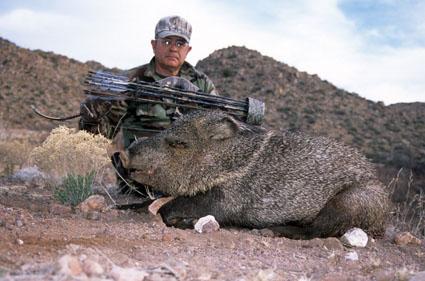|
Hunting for javelina pork roast is great when the seasons for venison are past. |
The odd little javelina—a.k.a. collared peccary—is ready-made for bowhunting. Finding them can sometimes prove tricky, but once located getting close isn't brain surgery as long as you keep the wind in your favor. Their only real defense is a razor-sharp nose, but their remaining senses are relatively poor. Just as importantly, they seem to confuse easily.
Locating prime javelina hotspots is easy, as the little tuskers leave plenty of sign while wandering and foraging. Their tiny, blunted cloven hoof prints are difficult to mistake with deer, oftentimes showing distinctive dew claws in mud or sand. Favorite foods include desert tubers and prickly-pear cactus, areas where javelina are feeding showing heavy rooting and shredded cactus. Water's also an obvious point of concentration. The desert Southwest is normally dry, javelina visiting water to drink and wallow. Desolate springs and stock ponds are hotspots during warm weather.
In Texas, where javelinas live in thorny mesquite and cactus jungles, bowhunters often scatter corn to lure desert pigs into the open. In the javelina strongholds of southern Arizona and southwestern New Mexico baiting is illegal. Hunters in those states use binoculars and careful probing instead to locate their prize. As with any other Western big game animal, quality binoculars are a boon to success, as there is a lot of empty space out there, and the little salt-and-pepper pigs can be difficult to separate from their surroundings. This is no different from hunting desert mule deer or Coues whitetail; gaining the high ground and using optics to pare the land down to manageable size. Patience is a virtue in this game, though javelinas are generally more gregarious, hence easier to find.
While glassing or trekking through prime habitat, keep your ears open for javelina grunts and squeals. Javelina can prove fairly vocal, grunting loudly while traveling in packs in order to keep tabs on one another. They also often bicker over a prime piece of cactus or root, creating sometimes ear-piercing squeals that can be heard from a great distance.
In thicker cover near major Southwestern rivers or creeks where cover is thicker, still-hunting can also prove productive and fun. You'll know a hotspot when you find it, as it will be crisscrossed by obvious trails and littered with the dog-like droppings and dished-out beds of resident java. Just remember to move against the wind and an encounter is more likely.
There are exaggerated tales of the dangers of javelina hunting. Those protruding, razor-sharp tusks reinforce this notion, but in truth javelina would rather run any time than fight. A wounded or cornered java could be a handful, no doubt, but given due respect the dangers are very slight. "Charging" javelinas no doubt are only trying to flee and run in the wrong direction. What the javelina does provide, though, is pure fun during the months of January (Arizona) through mid March (New Mexico; Texas offering year-round hunting) when nothing else is happening in way of big game hunting. And while you may not consider them big game, they do provide big fun in temperate climates.







